List of Hinduism (Sanatana Dharma) facts (unique, major, for kids & elders) | Frequently asked questions (FAQs) about Hinduism (with answers)
Namaste friends, how are you doing today? Welcome to #BhagavanBhakthi website / blog.
Bhagavan Lord Sri Krishna (Lakshmi Narasimha) (Vitthal) (Vishnu) (Rama) (Trivikrama) and Goddess Sri Rukmini (Lakshmi) blessings to you and your family!
In this website / blog, you will always learn about #Hinduism #Sanskrit language.
Also subscribe to my YouTube channel from this link #BhagavanBhakthi to view videos about #Hinduism #Sanskrit language.
Just before going to “List of Hinduism (Sanatana Dharma) facts (unique, major, for kids & elders) | Frequently asked questions (FAQs) about Hinduism (with answers)“, let us know a brief, basic and very important information.
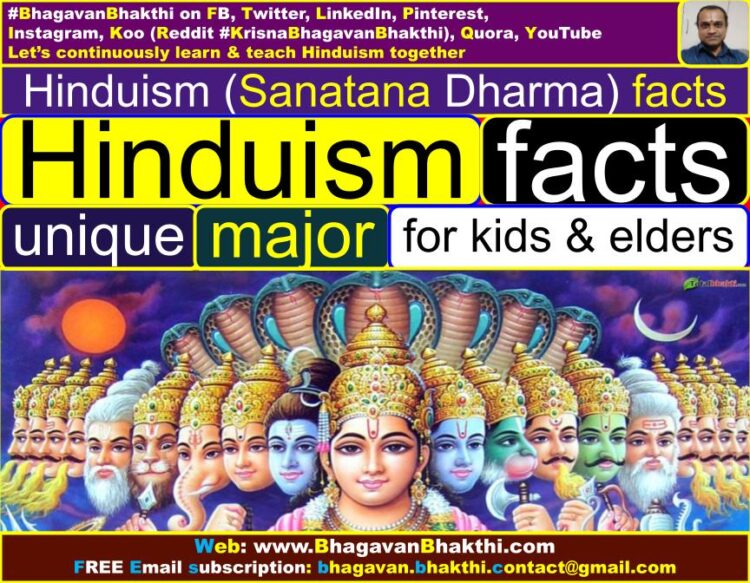
The modern Gurus of Hindu Sanatana Dharma are: A. Sri Shankaracharya Ji – His medium of teachings are based on Advaita. B. Sri Ramanujacharya Ji – His medium of teachings are based on ‘Vishishtadvaita’. C. Sri Madhwachara Ji – His medium of teachings are based on ‘Dvaita Siddhanta’.
Hindu Sanatana Dharma is the one and only Dharma which is existing on this earth since unknown age & time and all others are called as ‘Religions’.
Only in Hindu Sanatana Dharma Bhagavan / Ishwar / Brahma / God takes avatar. All the Vedas, Ramayana, Mahabharata and other Hindu Shastras (Texts / books) says Bhagavan Lord Sri Vishnu is the only Bhagavan / Ishwar / Brahma / God and all others are his followers.
All others are called as Devatas (Demigods) (Deities). All others follow the instructions of Bhagavan Lord Sri Vishnu.
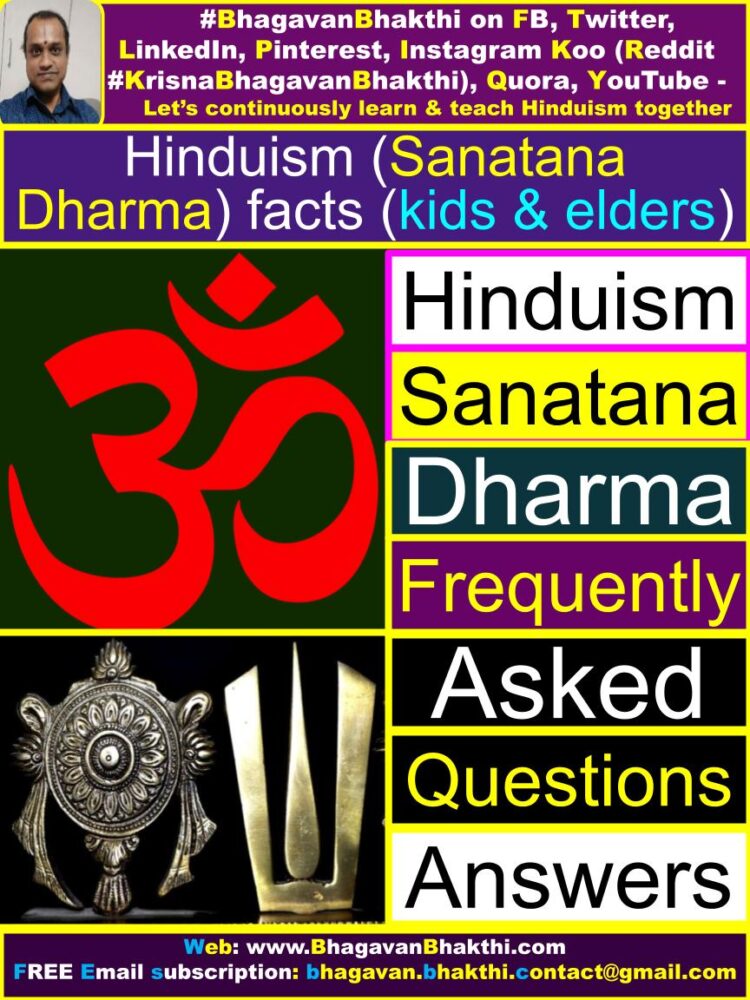
Now, let us know “What is Hinduism (Sanatan Dharma) facts are” as given below:
List of “Hinduism (Sanatana Dharma) facts (unique, major, for kids & elders)” | “Frequently asked questions (FAQs) about Hinduism (with answers)” are as given below:
Adi and Ananta (Hinduism time period) : Hindu Sanatana Dharma is called as ‘adi’ (Before the grand first) and is also called as ‘ananta’ (After the grand infinite).
Hinduism or Sanatana Dharma is existing since unknown timeframe and no one is aware of the exact timeframe of Hinduism. Some say 3k years, few others say 5k years. All these timeframes are man-made and not at all as per Hindu Texts.
As per Hindu Texts, one Kali Yuga = 432,000 years. One Dwapara Yuga = 2 * Kali Yuga = 864,000 years. One Treta Yuga = 3 * Kali Yuga = 1,296,000 years. One Satya Yuga = 4 * Kali Yuga = 1,728,000 years.
All Yugas collectively are called as one Mahayuga or Chaturyuga. Such one Mahayuga or Chaturyuga = 4,320,000 years. Then comes Manvantara = 306,720,000 years. Then finally it is one Brahma Kalpa, that is, one day for Lord Sri Brahma Deva = 4,320,000,000.
Lord Sri Brahma Deva’s total life span as per his planet is 100 years. The present Lord Sri Brahma Deva’s 51st year running. Such unlimited Lord Sri Brahma Deva have come and unlimited Lord Sri Brahma Deva will also come in future.
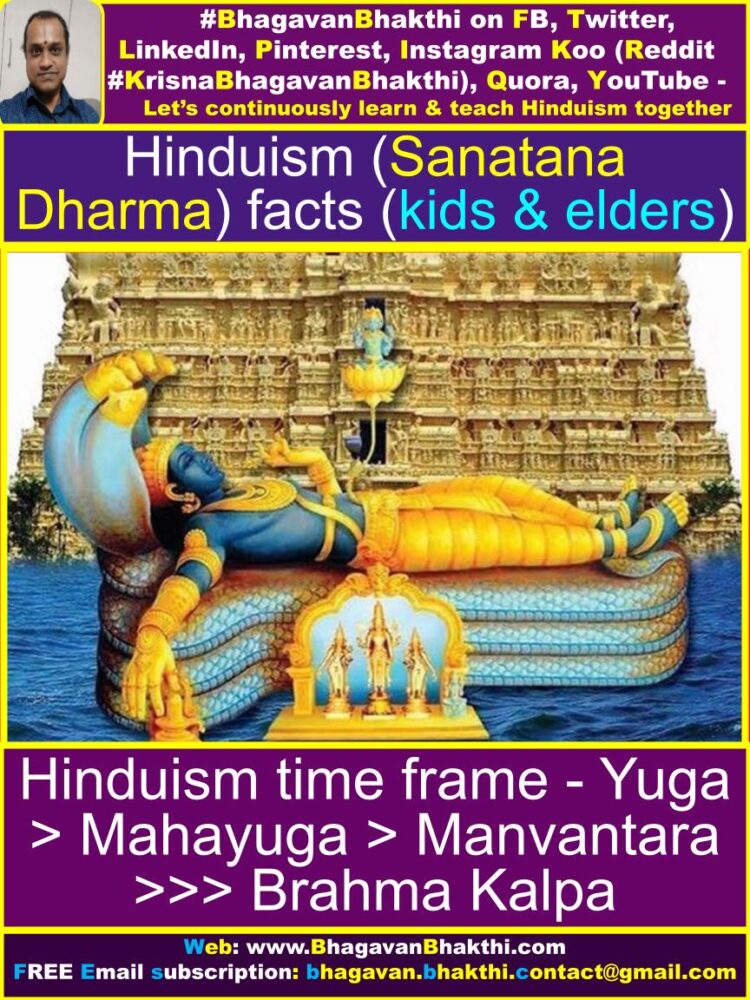
Does Hinduism has answers to all : Hinduism has every answer from religious to scientific. Hinduism says what to eat, what not to eat, where to go, where not to go, how & what to talk, what not to talk, when to wakeup and when to sleep, etc.
Hinduism or Sanatana Dharma also tells us when to have intercourse and when not to. It clearly explains what is the best and divine time and bad time to have copulation with your married partner. Hinduism completely prohibits mating between unmarried couples.
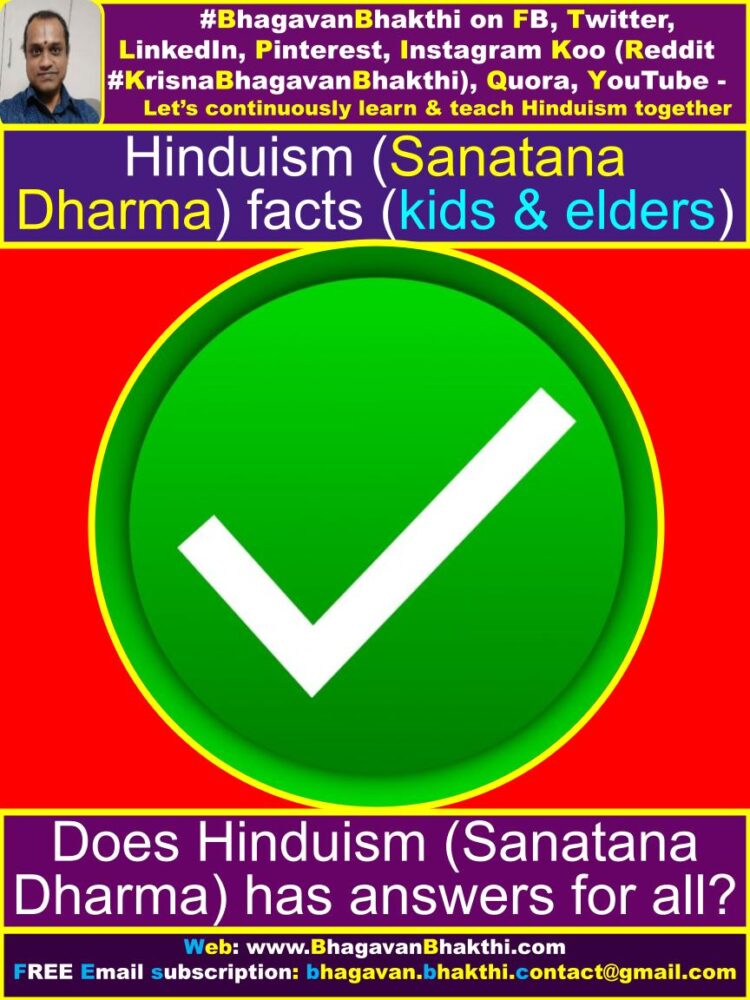
Do Hindus have a Bible : In Hinduism or Sanatana Dharma, we mainly have 4 Vedas namely Rigveda, Samaveda, Yajurveda, and Atharvaveda (Atharvanaveda).
Since human capacity in Kali Yuga is least compared to Satya (Krita) Yuga, Lord Sri Vishnu decided to give the information of these 4 Vedas in simple form like Mahabharata, Ramayana, Brahmasutra, Puranas etc.
Hindus have texts that explain space, celestial bodies, human anatomy, engineering, mathematics, science, biology, botany, zoology, etc. Hinduism or Sanatana Dharma has answers to all questions unlike other religions who have just one or two books.
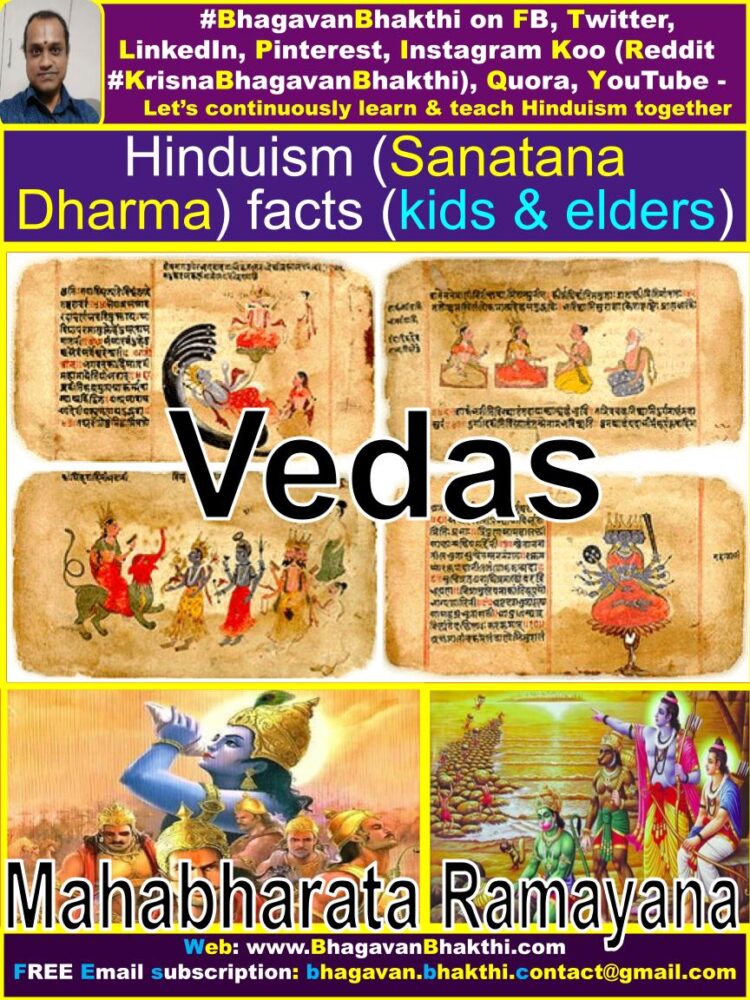
Are Hindu idol worshippers (What is deity praying) : Deity or idol prayer is one of the best form of prayer because we can feel the presence of Bhagavan (God) before us and it is well prescribed in Hindu Texts. Our Rishis and Sages have seen Lord Sri Vishnu and other Devatas (Demigods).
And our Rishis and Munis have carved deities on stone and have done the ‘prana pratishtapana’ (प्राण प्रतिष्टापन) and have invited God Lord Sri Vishnu and other Devatas (Demigods) to stay in the deity or idol forever.
As in Kaliyuga not everyone are not blessed to see God directly, we have to look at the God within deity i.e. ‘antaryami’ i.e. the God present within that deity. Just as we bow to the flag of our country, even if it is just a piece of cloth, we do not bow to the cloth, but to the country.
Similarly, we are not just worshiping or doing pooja of the stone or deity. But, we are doing puja or worship of Lord Sri Vishnu and other Devatas (Demigods) who are present inside that deity and stone.
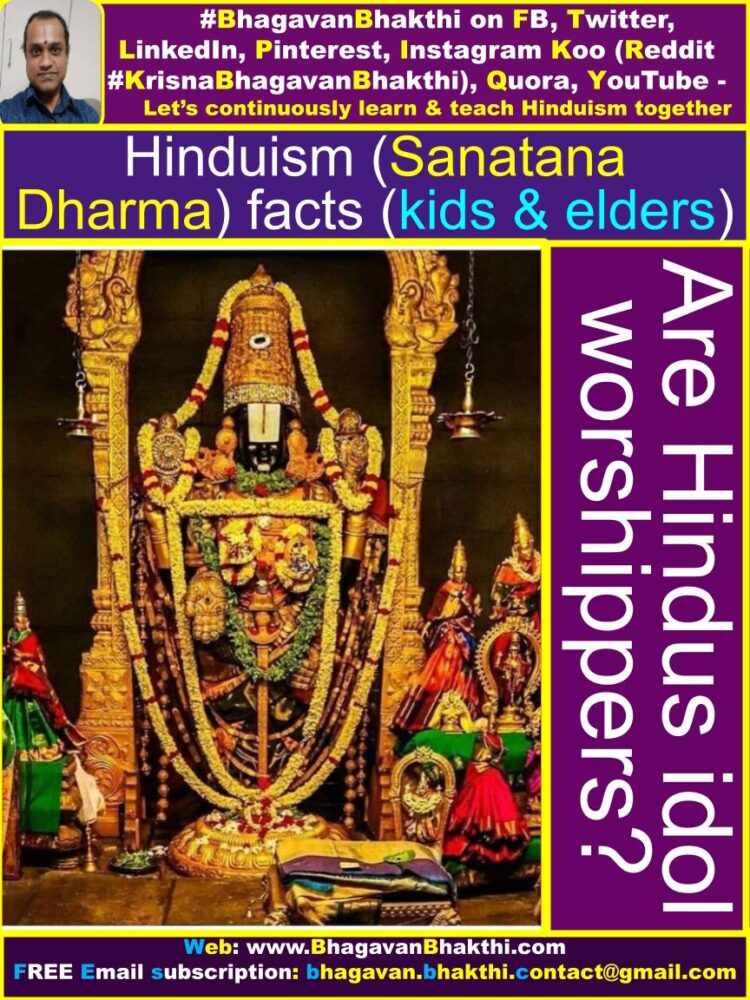
Why do many Hindus wear a dot near the middle of their forehead (What is the mark on a Hindu woman’s forehead) (Importance of tilak on forehead) :
This dot or markings serve two purposes in forehead and also provide a basis for the development of mind and intellect. It purifies the mind and brings intelligence both mundane and spiritual.
A traditional use of Gopi Chandan (tilak) is to apply it on the forehead (tilak / dot) on the forehead as it helps cool the nerves. When applied, tilak (Gopi Chandan) purifies one’s body and provides protection from ghosts, evil influences and nightmares.
The more ancient and right form is to apply it as a long tilak. The two lines with Gopi Chandana (tilak) represents Lord Sri Krishna (Vishnu) lotus feet and the middle black line represents Goddess Lakshmi Devi.
If someone doesn’t apply Gopi Chandana in the form of Tilak, then his / her forehead is considered as the cremation land (graveyard) (śmaśāna-gr̥ham / Shmashana-Gruham).
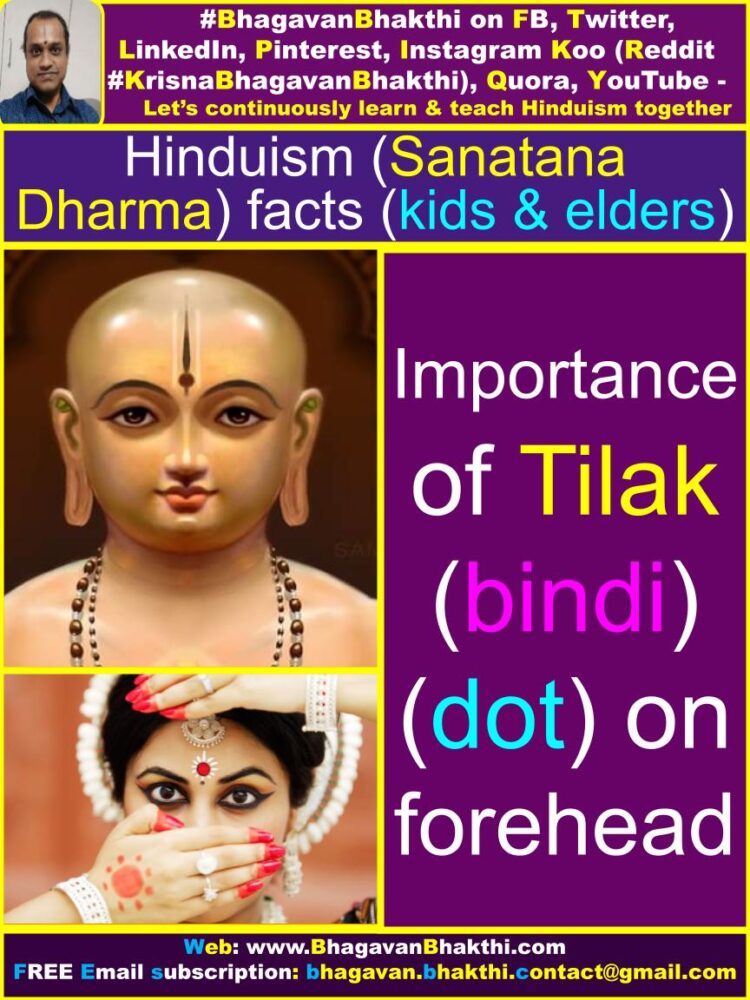
Are the Gods of Hinduism really married (Which Hindu gods are married?) (Which Hindu gods have never been married?) : Starting from Lord Sri Vishnu all have married.
But the main purpose of marriage among them is not about copulation. But rather to show to the world that marriage is a must in everyone’s life and this is one of the ways of getting the Mukti / Moksha (liberation).
A person who is married is called as ‘grihasta’ (householder). He needs to follow a group of rules and regulations, and similarly he will have many freedoms too to perform after marriage.
The Hindu Gods and Goddesses names (husband and wife) is as given below:
Lord Sri Vishnu has married Goddess Sri Lakshmi Devi. | Lord Sri Brahma Deva has married Goddess Sri Sarasvati Devi. | Lord Sri Vayu Deva has married Goddess Sri Bharati Devi. |
Lord Sri Adishesha has married to Goddess Sri Varuni Devi. | Lord Sri Garuda has married to Goddess Sri Sauparni Devi. | Lord Shiva has married to Goddess Sri Parvati Devi. | Lord Sri Indra has married to Goddess Sri Sachi Devi. |
Lord Sri Kama has married to Goddess Sri Rati Devi. | Lord Sri Surya has married to Goddess Sri Saranyu and Goddess Sri Chhaya Devi. | Lord Sri Chandra has married to Goddess Sri Rohini Devi and 27 others. |

All the Gods and Goddesses in Hinduism have married in their original form. Hanuman has not married in this avatar, but in his original form of Lord Vayu, he has married to Goddess Bharati.
Information about caste and untouchability in India (Hinduism) : In India and Hinduism, there is no such thing as caste. We have four varnas and their names are – Brahmin, Kshatriya, Vaishya and Shudra.
A Brahmin (Brahmana) is one who learns and teaches Hindu texts. A Kshatriya is one who protects the country. A trader is a Vaishya. A Shudra is one who does agriculture and helps the people of other varnas.
There was no such thing as untouchability in Hinduism or in India. But some people without proper knowledge of Hindu scriptures started avoiding certain types of people and telling them not to enter temples.
For example, if you have eaten meat and want to enter the temple, it should be avoided. One cannot start the day without taking a bath and similarly one cannot worship or enter a temple without taking bath. Here cleanliness and hygiene were given more importance than the caste system.
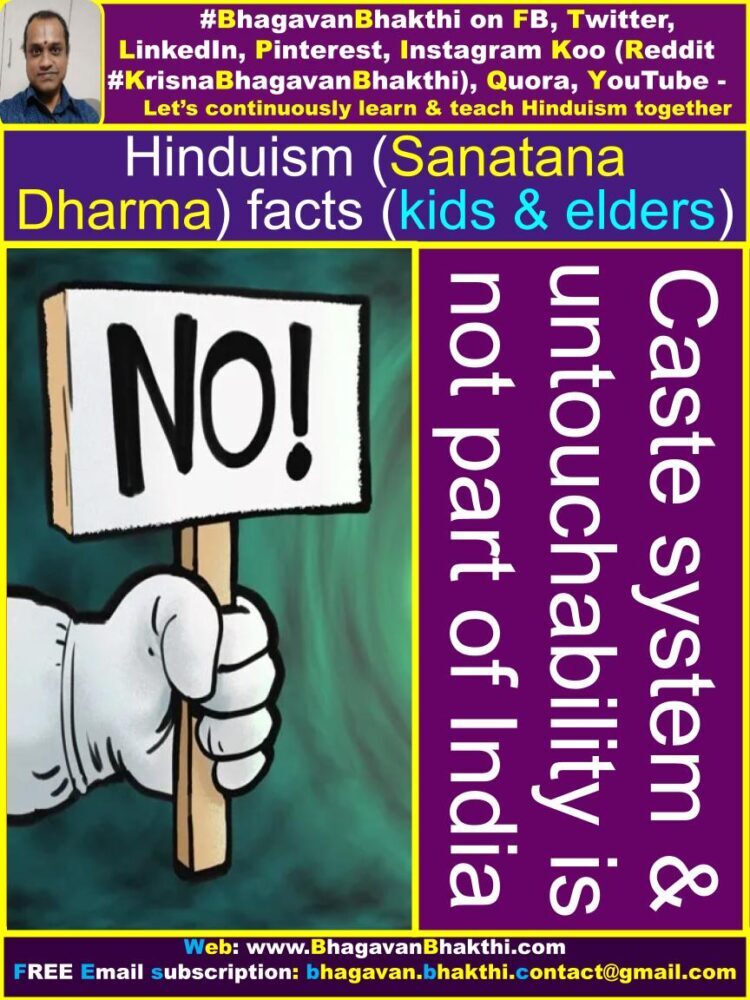
These are some of the things that are restricted in Hinduism. When foreigners, especially Europeans started conquering India, they changed the mindset of Indians and installed all the unnecessary information in our minds.
This is how caste system and untouchability started in India. All these were established by Europeans, especially the British in India (British East India Company).
Is yoga a Hindu practice : Yoga, which is mentioned in Hindu Texts and it is as old as the Sanatana Dharma (Hinduism) is and no one knows about the exact timeframe of the initiation of the Yoga.
In the modern time, a Sage called Patanjali re-initiated the practice of yoga in India. Patanjali is often considered the father of ‘modern yoga’ and his Yoga-Sûtras still strongly influence most styles of modern yoga.
But, this doesn’t mean Patanjali is the inventor or he started the Yoga practice in India for the first time. Not at all. Yoga is present since unknown timeframe in India.
Just like Lord (Sage) Sri Vedavyasa gave us the short form of Vedas, it doesn’t means Vedas was started just 5k years back. Vedas are present since the unknown timeframe and will continue to stay on this earth until the infinite years and same is with Yoga also.
Yoga or Yogasana is nothing to do with Dharma or religion. It is all about health and keeping boy fit and fun. If you are healthy, you can do many things, but if you are unhealthy, you are in real trouble. Yoga shows us the way of a healthy and blissful life.
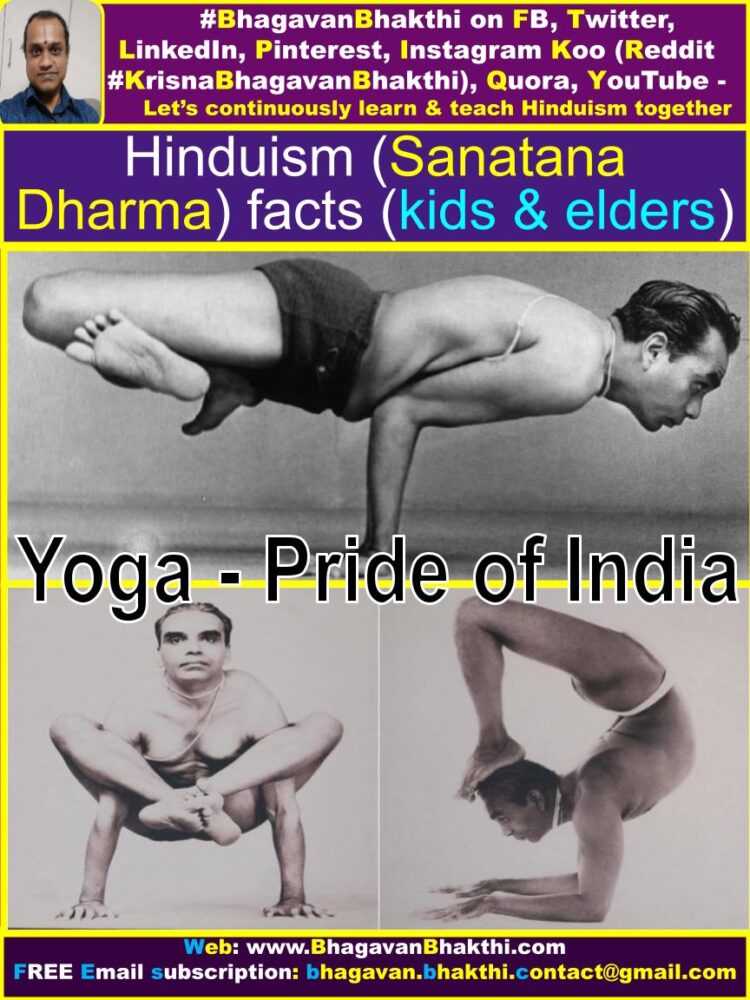
In the modern time, the Indian government, under the leadership of Prime Minister Sri Narendra Modi, strongly encourages Yoga (Yogasana) as a cultural practice that promotes physical and spiritual health.
Why do some Hindu Gods have animal features? – Let us understand this with some examples according to Hindu Puranas. Let us first take the example of Lord Ganesha and his elephant face.
Lord Ganesha elephant face – According to the Brahma Vaivarta Purana Lord Shri Ganesha was initially born with an normal body (not a human body of course, but a divine Devata / Demigod body).
Lord Sri Vishnu has a form of an elephant with his head resembling the form of an elephant, just similar to today’s Lord Sri Ganesha. Thus, Lord Shri Ganesha starts meditating on this form of Lord Shri Vishnu for several years. Lord Sri Vishnu is pleased with this meditation.
Lord Shri Vishnu asks the normal body Lord Shri Ganesha what he wants and why he is meditating on the elephant faced Lord Shri Vishnu. Lord Shri Ganesha asks for a boon to have a similar elephant form of Lord Shri Vishnu.
Thus, Lord Sri Vishnu blesses Lord Sri Ganesha, that he soon assumes the form of elephant-faced Lord Sri Ganesha. Then the story goes that Lord Shiva cuts off Lord Ganesha’s head and finally replaces his head with an elephant’s head.
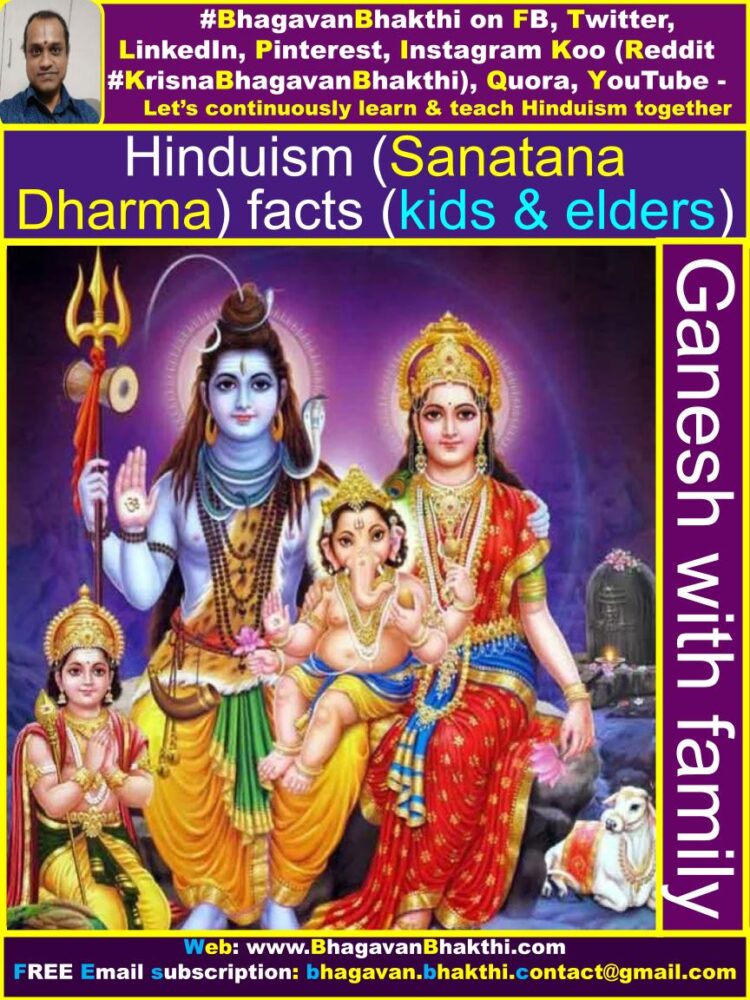
About Lord Narasimha form – Hiranyakashipu (Hiranyakashyap) earlier had got a boon from Lord Brahma that he can’t be killed by any creatures created by Lord Brahma.
We should note that only Lord Sri Vishnu and Goddess Sri Lakshmi are the two who was not created by Lord Brahma and all others were created by Lord Brahma.
Lord Sri Vishnu knows anything and everything and thus he takes the avatar of Lord Sri Narasimha, that is, half-lion and half-man and with highest ease kills the demon King Hiranyakashipu.
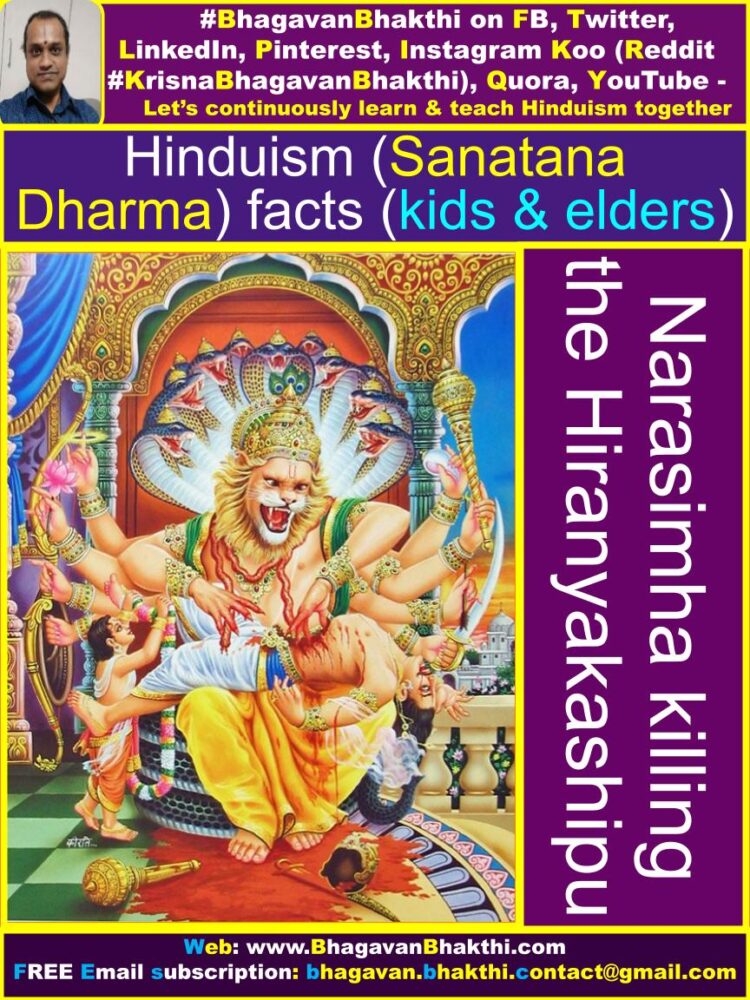
Why do Hindus cremate the dead? – According to Hinduism, the body of the deceased must be merged with the ‘pancha bhuta’ (nature’s five basic elements) before sunset. For this the best way is to cremate the dead body as soon as possible.
Cremation helps protect the dead body from any negative attack like animals, insects, cannibals etc. If the person has a severe illness, burying the person can cause environmental problems. So cremation is the best way.
You can know full information from here “Which is better cremation or burial“.
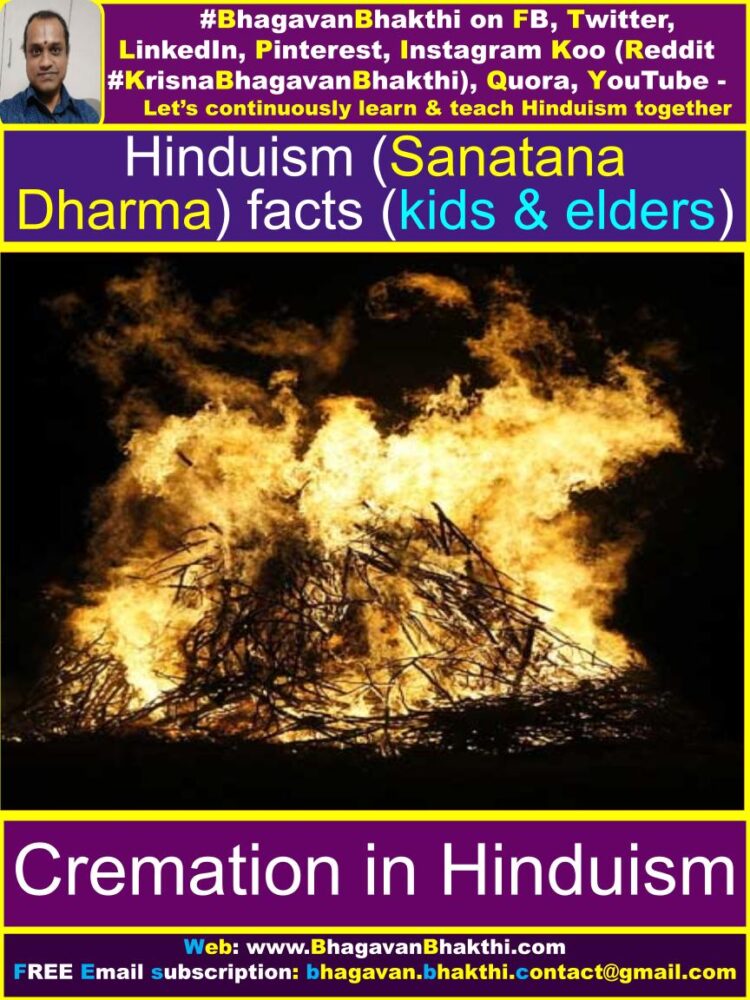
What do the Vishnu Dashavatars depict : How the evolution took place from Matsya (fish, living in water), Kurma (tortoise, living in both water and on land), Varaha (boar, living only on land).
Then, Narasimha (how the living beings started to change from animals to humans), Vamana (the development of humans starting from the dwarfism), Parashurama (humans starting to take revenge).
Then, Rama (how to be a Purushottama – how to be a perfect man), Krishna (the rules and the regulations of the life – Bhagavad Gita, Vishnu Sahasranama, Mahabharata, etc.)
Then, Buddha (only fighting is not the correct path – ahimsa is more important and more powerful) and Kalki (all the Adharmis – unrighteous people should be eliminated and bring back the Dharma).
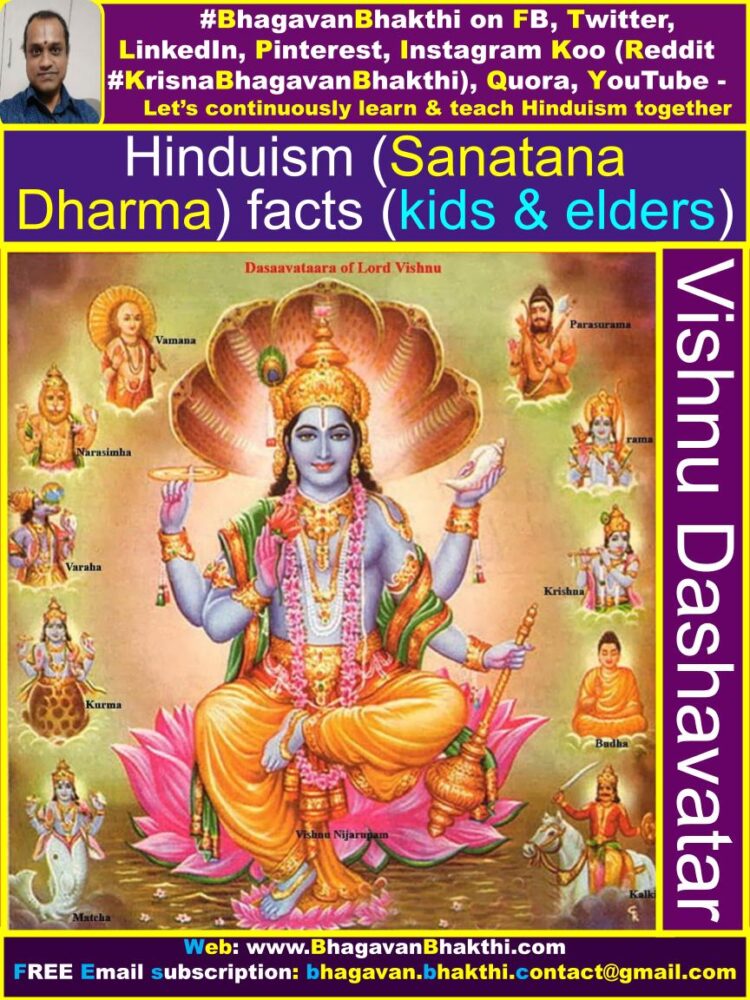
Who is the founder of Hinduism : Bhagavan Lord Sri Vishnu is the founder of the Hinduism / Sanatana Dharma. He is present since unknown timeframe. He was present 3k years before, 5k years before, 10 lakh years before.
Lord Sri Vishnu was also present when Lord Shiva was not yet born. Lord Sri Vishnu was present when Lord Sri Brahma Deva was not yet born. Lord Sri Vishnu was present before the ‘pralaya’ (great tribulation).
Lord Sri Vishnu has seen infinite number of pralayas (great tribulations) and he is the cause for the same. Just like we clean our home at lease once an year. Lord Sri Vishnu cleans the earth and universe as per his wish and will.
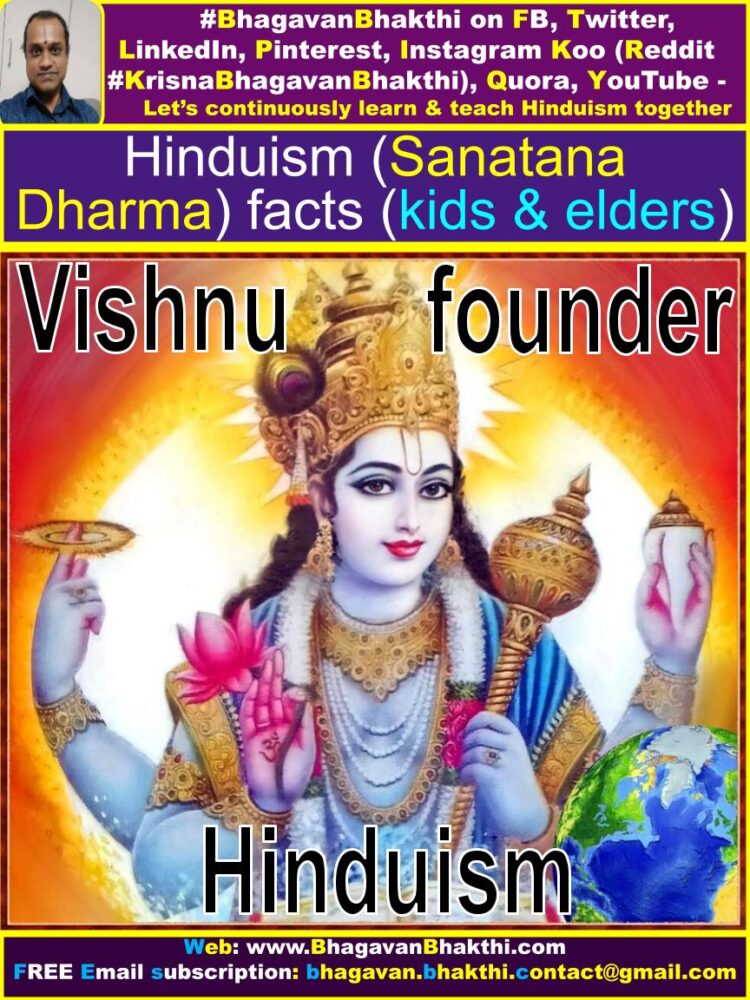
Why does Hinduism have so many gods : As per the inner meaning of the Hindu Texts, in Hinduism or Sanatana Dharma, there is only one God Lord Sri Vishnu.
And all others are known as Devatas (Demigods) starting from Goddess Lakshmi, Lord Brahma, Lord Vayu, Goddess Sarasvati, Goddess Bharati, Lord Shiva, Shan Mahishis, Goddess Parvati, Lord Indra, Lord Kama, Lord Pravaha Vayu, Lord Surya, Lord Chandra, etc.
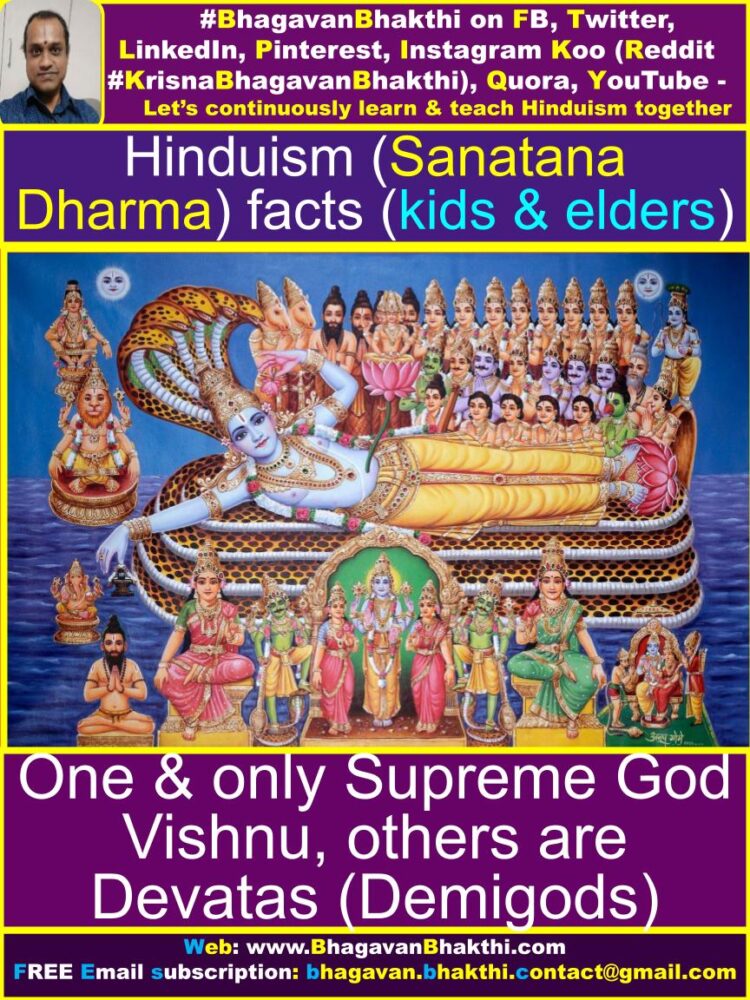
Do Hindus believe in reincarnation [What the meaning of reincarnation (avatar) in Hinduism] : Hinduism / Sanatana Dharma is cycle type (rotation) of Dharma, that is, we believe in rebirths and reincarnations (avatars) as per Hindu Texts.
Starting from Lord Sri Vishnu all take avatars. He doesn’t take birth and he doesn’t has death. But he takes avatar as per his wish and will. If he wishes to take avatar of fish, he takes Matsya avatar. Similarly tortoise (Kurma), Varaha (boar), Narasimha (half lion and half man).
Lord Sri Vishnu has taken swan avatar called Hamsa (Hansa). He has taken Lord Sri Rama, Lord Sri Parashurama, Lord Sri Krishna, Lord Sri Vamana avatars and at the end of this Kali Yuga, he will take Lord Kalki avatar. There is no one who can stop him.
Similarly, many other Devatas (Demigods) also take avatars. But their avatars and Lord Sri Vishnu avatars are different. Lord Sri Vishnu takes avatars completely independently and he doesn’t depend on anyone for anything.
But, all others are completely dependent on Lord Sri Vishnu to take the avatars (reincarnations). Starting from Goddess Lakshmi, Lord Brahma, Lord Vayu, Goddess Sarasvati, Goddess Bharti, Lord Shiva, Goddess Parvati, Lord Indra are completely dependent on Lord Sri Vishnu.
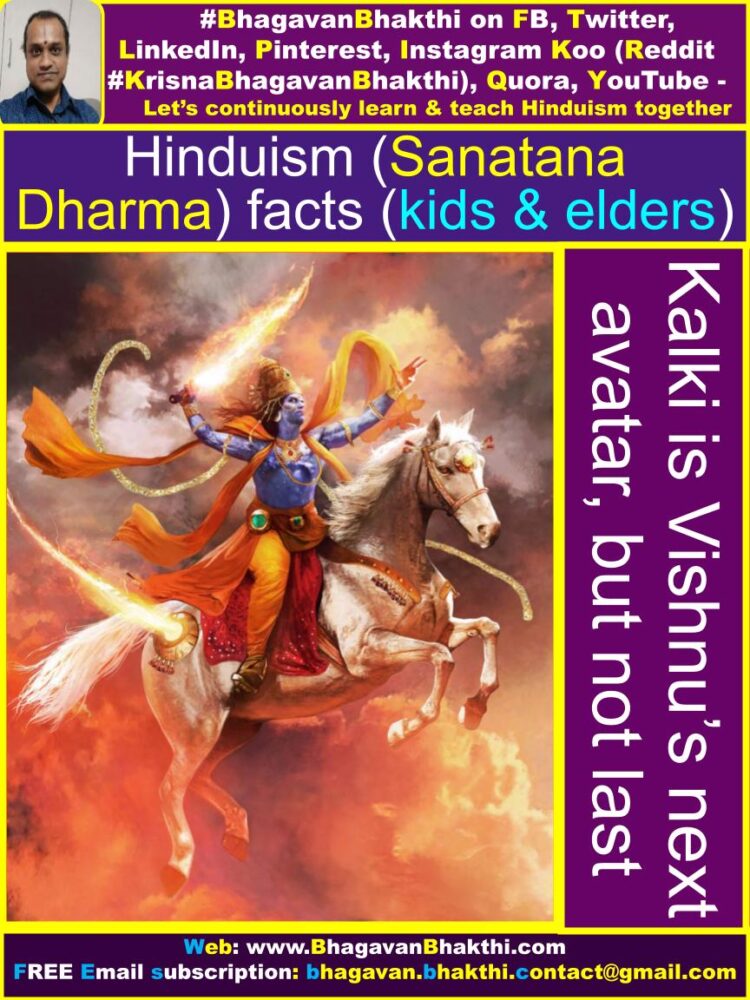
Why does Hinduism worship the cow (Why Hindu worship cow) : Lord Sri Vishnu has blessed mother Gau (Cow) that in her special present of all the Devatas (Demigods) including Himself will be always present.
In Cow’s four legs there reside the four scriptural Vedas, her horns has the special presence of Lord Brahma (tip), Lord Vishnu (middle) and Lord Shiva (base), in her eyes Lord Surya (Sun) and Lord Chandra (Moon) are present. Similarly in Cow’s shoulders the fire-god Lord Agni and the wind-god Lord Vayu is present.
More over a Cow’s milk is considered as not just milk in Hinduism, but it is considered as the ‘amrita’. Without Cow’s milk no human can live a healthy life. The ingredients of Cow’s milk are: buttermilk, whey, ghee, caseins and skim milk.
The main nutrients in Cow’s milk are: calcium, riboflavin, phosphorous, vitamins A and B12, potassium, magnesium, zinc and iodine.
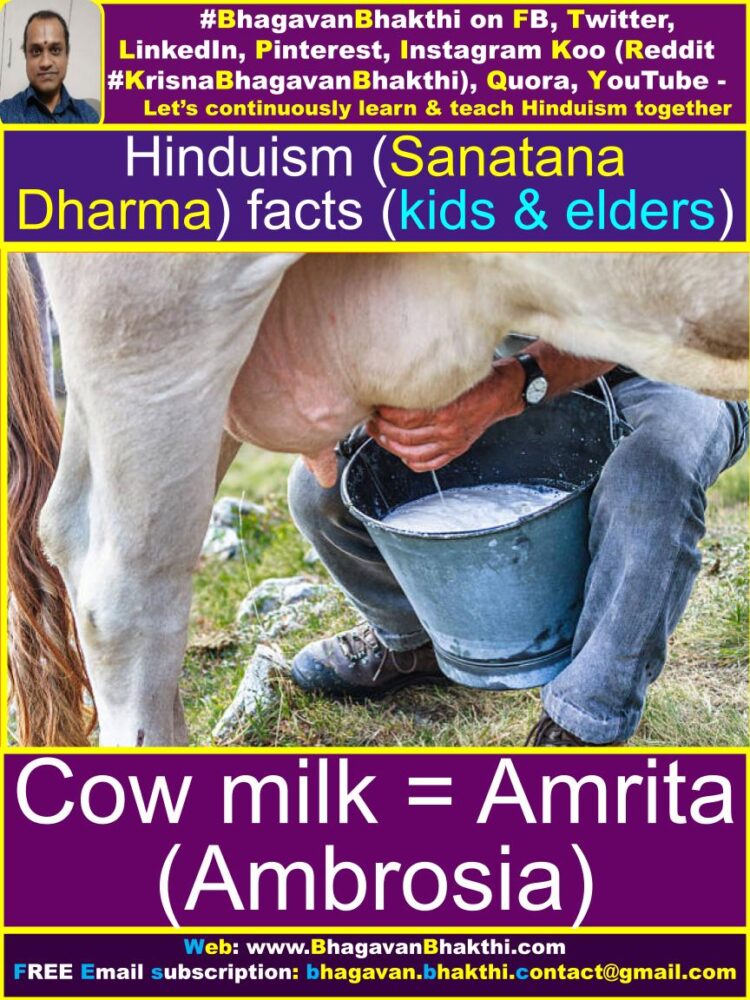
In Rig Veda 9.46.4 and Viṣṇu Purāṇa 1.19.65 the following shloka tells us clearly how one should treat the cow & a learned man
नमो ब्रह्मण्य देवाय गो ब्राह्मण हिताय च ।
जगत् हिताय कृष्णाय गोविंदाय नमो नमः ॥
ನಮೋ ಬ್ರಹ್ಮಣ್ಯ ದೇವಾಯ ಗೋ ಬ್ರಾಹ್ಮಣ ಹಿತಾಯ ಚ ।
ಜಗತ್ ಹಿತಾಯ ಕೃಷ್ಣಾಯ ಗೋವಿಂದಾಯ ನಮೋ ನಮಃ ॥
namō brahmaṇya dēvāya gō brāhmaṇa hitāya ca।
jagat hitāya kr̥ṣṇāya gōvindāya namō namaḥ॥
Meaning of this sloka : “My Lord Sri Krishna (Vishnu), You are the well-wisher of the cows and the brāhmaṇas (who learn and teach Hindu Texts corrects), and You are the well-wisher of the entire human society and world.”
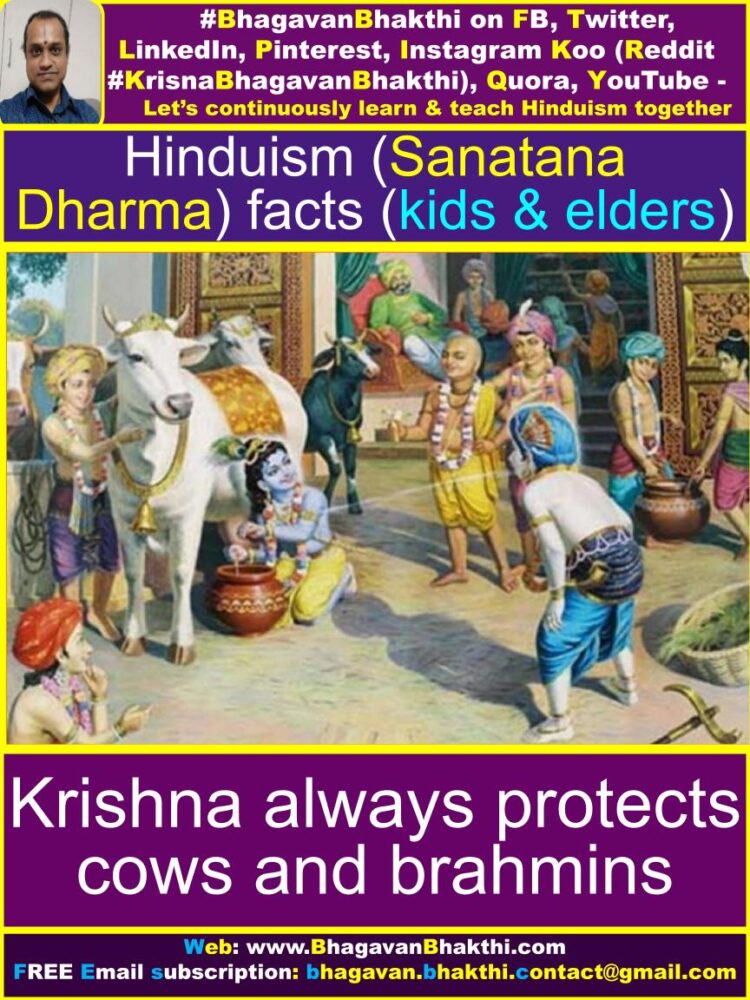
What is Karma (Does life depends on Karmas as per Hinduism) : After one dies, he / she will get next life as per his / her earlier Karmas (including the present Karmas and the earlier lives’ Karmas).
If we have done good Karmas earlier (including our earlier lives), we will get a happy and prosperous life. Similarly, if we have done bad Karmas, we will get life as per our Karmas and we have to face all our problems in our life.
Starting from Lord Brahma all are dependent on Karmas. Expect Lord Sri Vishnu, all get life as per our Karmas. Lord Sri Vishnu is called as ‘akarmi’, that is, Karma can’t affect him and he is free and independent of all the Karmas unlike we humans.
If Lord Sri Vishnu wants to laugh, he will laugh, smile and sometimes does the vidambana (pastimes) of crying and facing difficult situation in his life. But, we should always remember that this is just a pastime of Lord Sri Vishnu and he never ever faces any hardships in his original form or in his avatar forms.
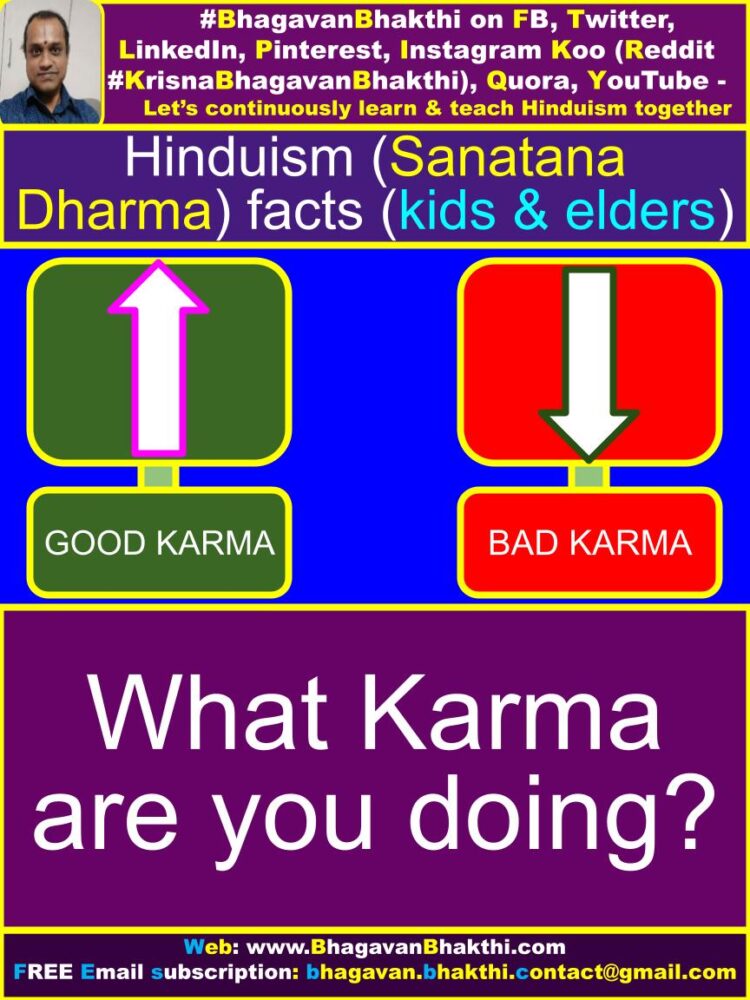
Karma is is not only for humans, but this is same for animals, plants, etc. including both living and non-living organisms. All will happiness and hardships as per our Karma, except Lord Sri Vishnu.
Does Karma affect on the celestial bodies too : Again, this is not only for earth’s living and non-living beings / organisms. But this holds good even for outer celestial things including planets, stars, solar systems, universes etc.
Ever day many stars, planets, universe, solar system, etc. born. Similarly, everyday many stars, planets, universe, solar system, etc. die. Even these celestial things have to face Karma.
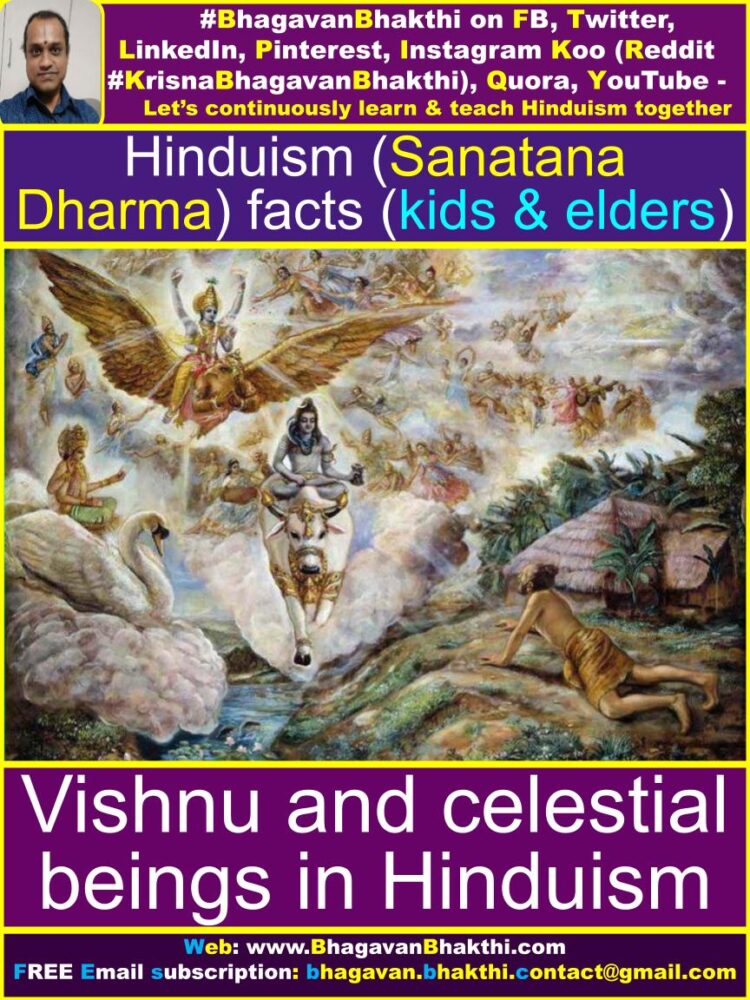
What does the ranks in Hinduism for Devatas (Demigods) : Brahma, Sarasvati, Rudra, Indra etc. are all padavis (ranks) and not names. Even they have the end and as soon as they complete their tenure, a new Brahma, Sarasvati, Rudra, Indra etc. will be born.
Just like Presidents, Prime Ministers, Ministers, etc. change in every 4 years or 5 years as per the country’s rules. Similarly, Lord Brahma, Goddess Sarasvati, Lord Rudra, Lord Indra, etc. change after the Maha Kalpa or Brahma Kalpa.
At the start of every Maha Kalpa or Brahma Kalpa, a new Brahma takes birth from the navel of Lord Sri Vishnu. From Brahma different Devatas (Demigods) are born including Lord Shiva.
Then later, from Rishis great Samrats (Emperors) and others are born. From these Samrats (Emperors) other great people are born. And this cycle keeps on continuing until the end of the Brahma Kalpa or Maha Kalpa.
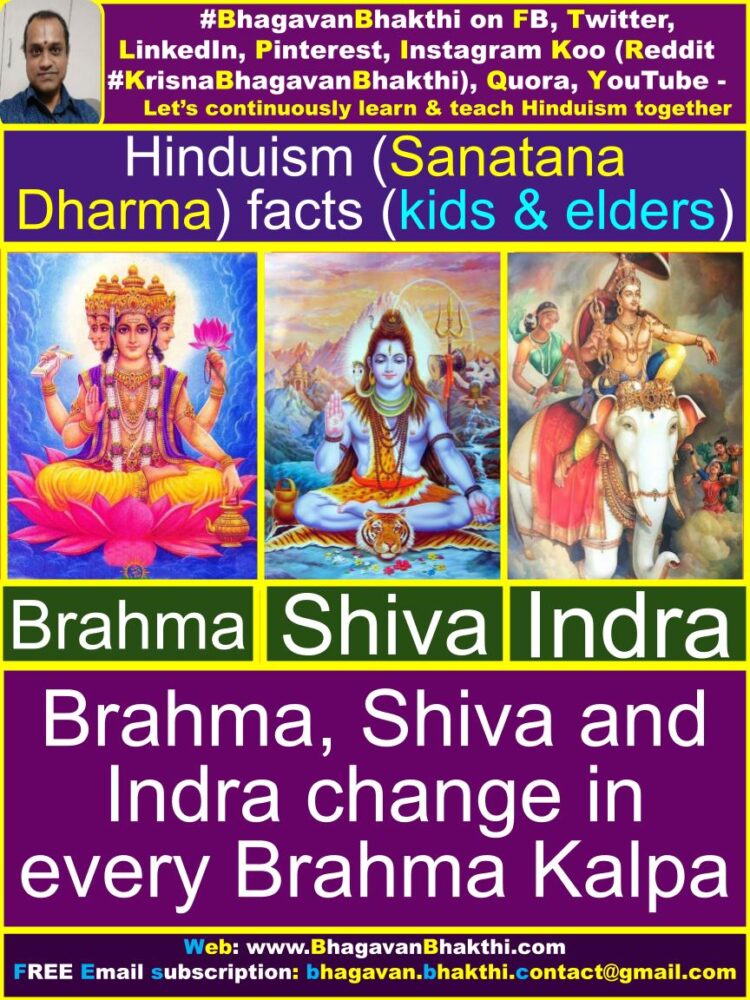
Is Vishnu is the Ultimate and Supreme God : Except Bhagavan Lord Sri Vishnu and Goddess Sri Lakshmi Devi all have to pass through different lives. Goddess Sri Laskhmi Devi is called as ‘nitya mukta’, that is, she is free from all bondages, but she is completely dependent on Bhagavan Lord Sri Vishnu.
Only Lord Sri Vishnu doesn’t has birth and death. Since he doesn’t has birth and death, he is called as ‘Supreme God’ in all the Hindu Texts starting from Vedas, Mahabharata, Ramayana, Puranas, Brahmasutras, etc.
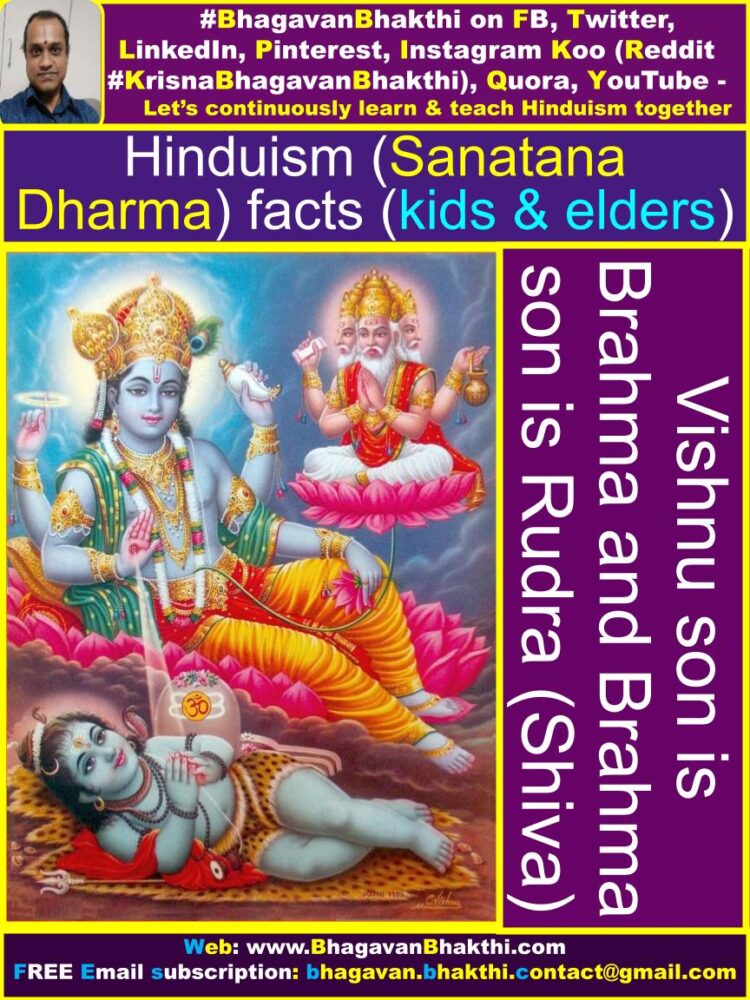
Is Vedavyasa an avatar of Vishnu : Lord (Sage) Sri Vedavyasa is an avatar of Bhagavan Lord Sri Vishnu. There is no different between Lord Sri Vishnu and Lord (Sage) Sri Vedavyasa.
The meaning of Vedavyasa is, he is the one who ‘divides the Vedas, and other Hindu divine scriptures’, so that it will be easy for the less knowledgeable people to understand the divine Hindu texts easily.
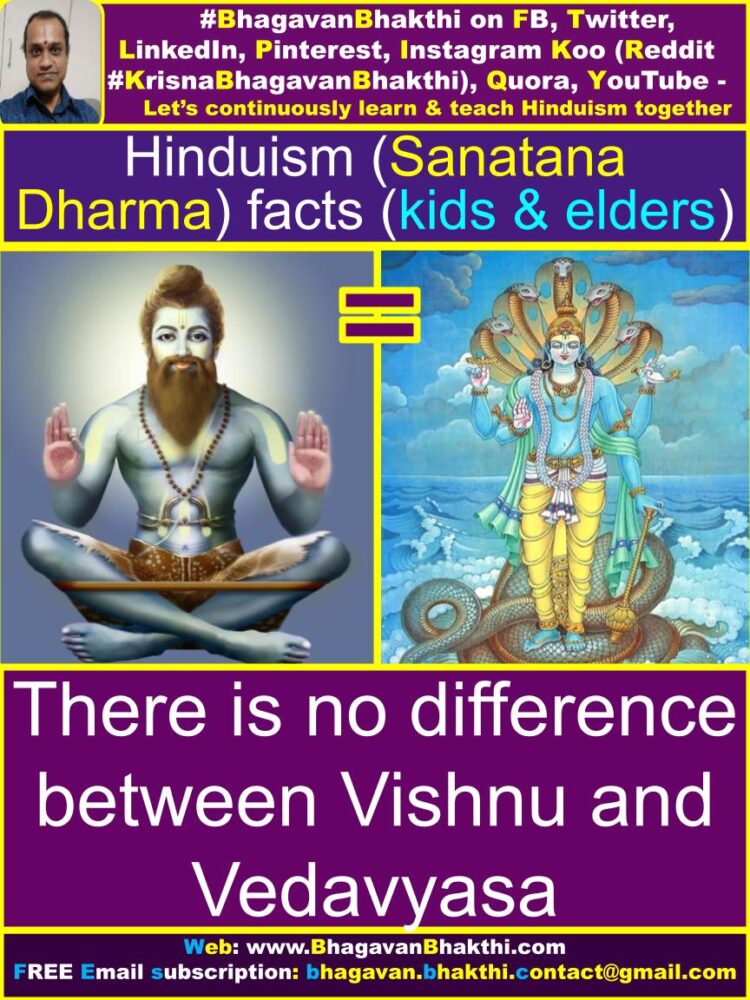
What is the Kali Yuga influence : Even though, Lord (Sage) Sri Vedavyasa has divided the Hindu divine texts for the sake of the Kali Yuga people,
but Kali Yuga people are so much ignorant, maximum number of people are not at all interested in knowing the greatness of Hindu divine texts divinity and greatness.
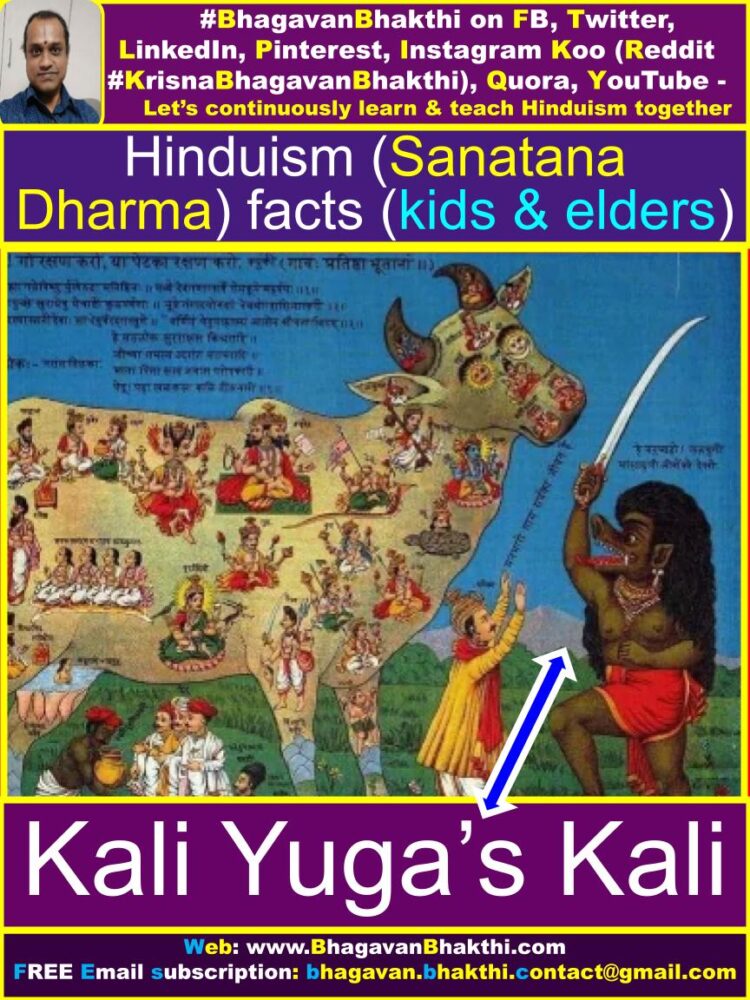
Name few Hindu texts : The different Hindu divine texts are: Mahabharata (this includes Bhagavad Gita), Four Vedas (Rigveda, Yajurveda, Samaveda and Atharvaveda), Ramayana, Puranas, Upanishads, Smriti, Brahmasutra etc.
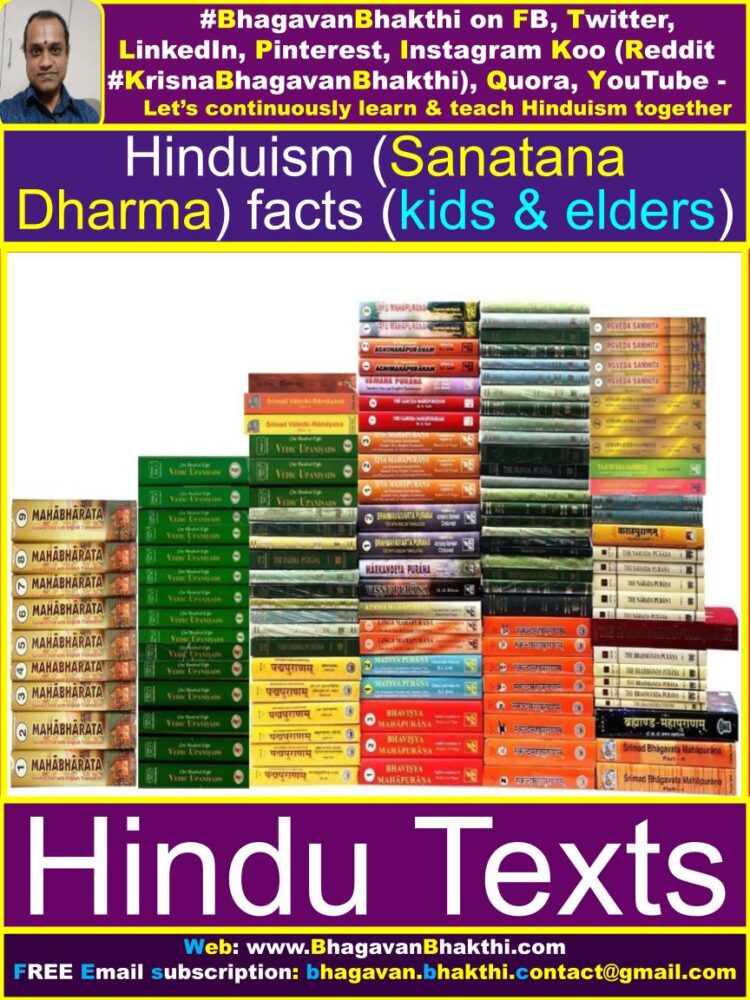
Is Hinduism monotheist or polytheist : Hinduism (Sanatana Dharma) believes only Monotheism and not at all in polytheism as propaganda done by Europeans and others.
Lord Sri Vishnu is the only God in Hinduism and all others are known as Devatas (Demigods). All have to listen to the instructions of Lord Sri Vishnu starting from Lord Brahma, Goddess Sarasvati, Lord Vayu, Goddess Bharti, Lord Shiva, Goddess Parvati, Lord Indra, etc.
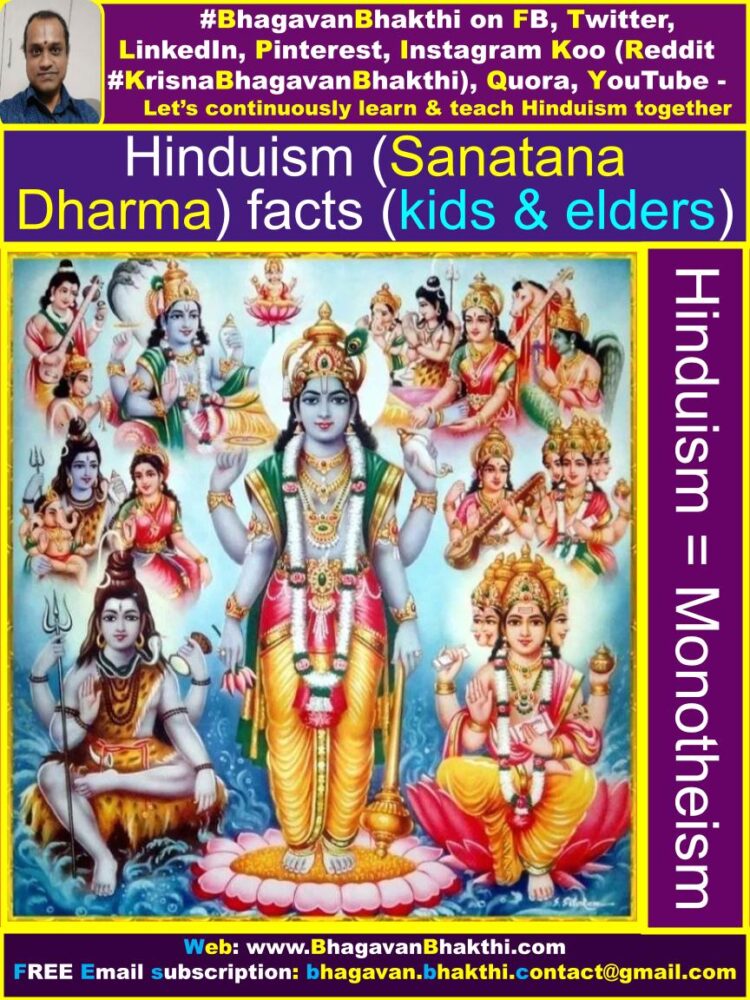
Who is most beloved to Vishnu : Goddess Sri Maha Lakshmi Devi is the most beloved to Bhagavan Lord Sri Vishnu, followed by:
Brahma Deva, Vayu Deva, Sarasvati Devi, Bharti Devi, Rudra Deva, Shan Mahishis, Goddess Parvati Devi, Indra Deva, Kama Deva, Pravaha Vayu Deva, Surya Deva, Chandra Deva, etc.
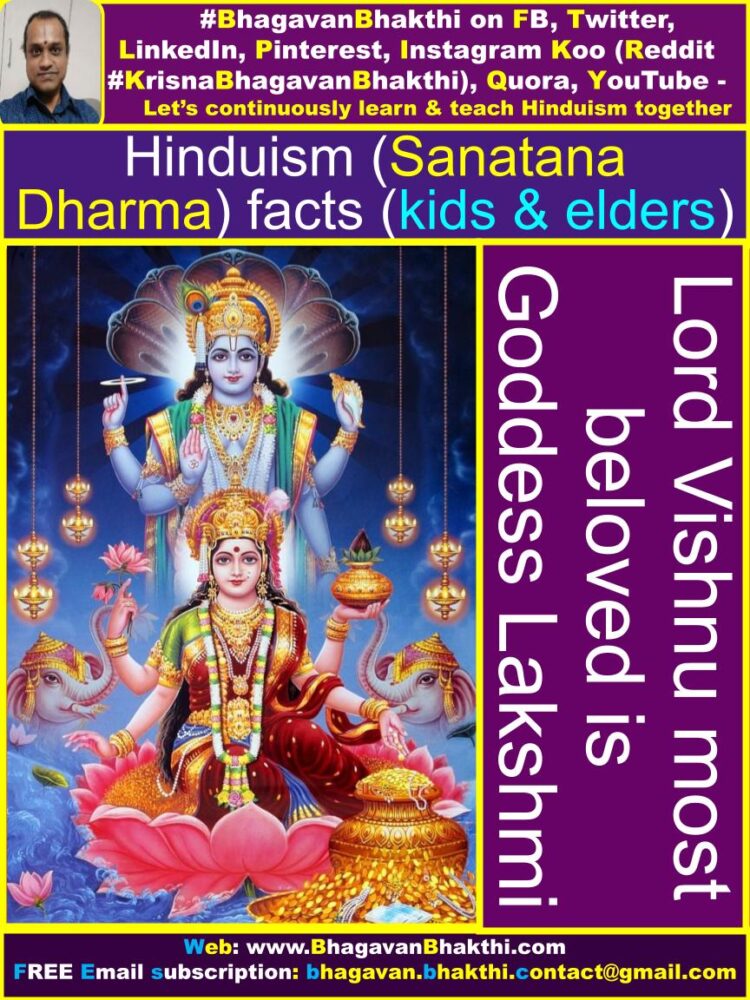
What are Śruti and Smṛti : Hindu Sanatana Dharma shastras (Divine Texts) are mainly classified into Śruti (Shruti) (“hearing”) and Smṛti (Smriti) (“remembering”).
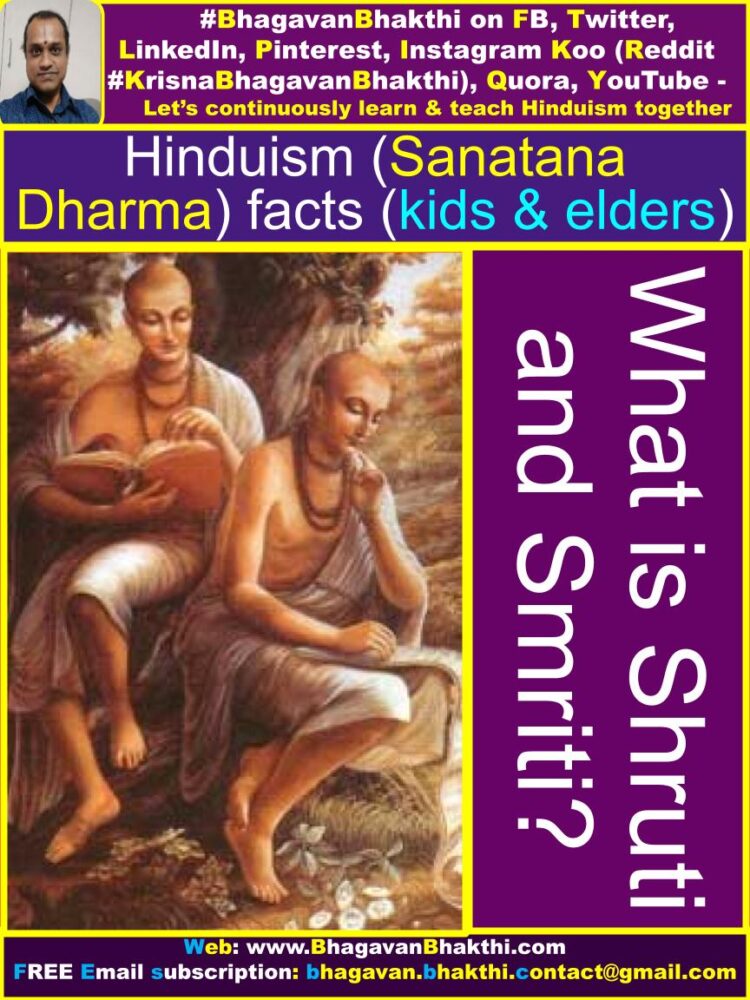
Names of six āstika schools (Darshanas) : In Hindu Sanatana Dharma there are six āstika schools of Hinduism and this recognizes the authority of the Vedas, namely Sānkhya, Yoga, Nyāya, Vaisheshika, Mimāmsā and Vedānta.
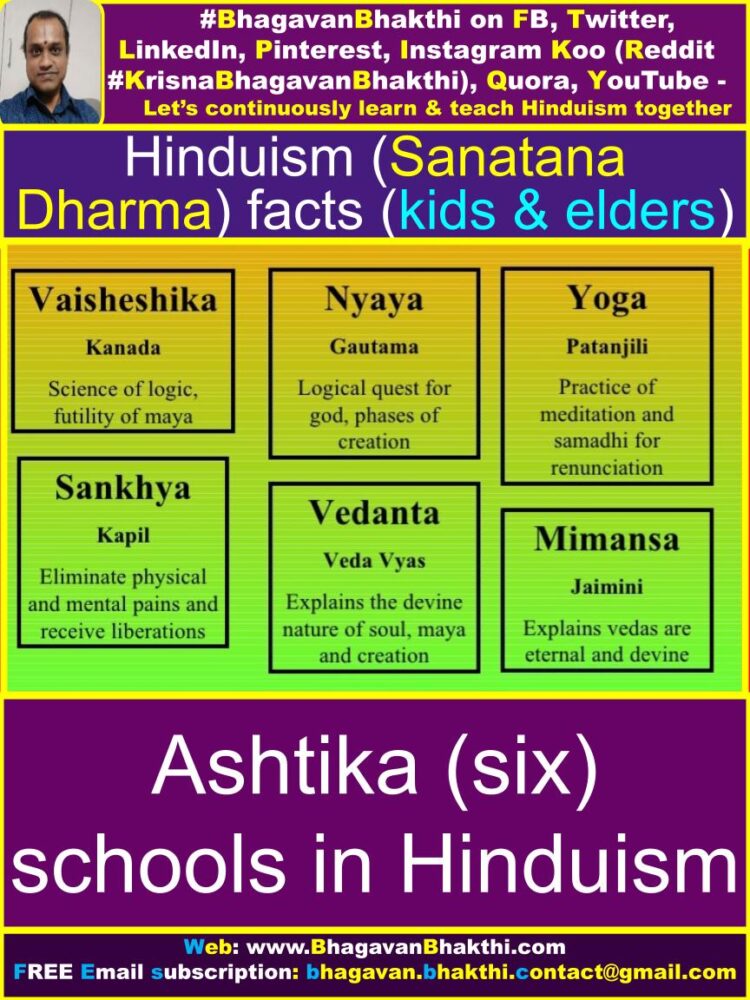
If you are aware of any such things, please let me know in the Comment box, so that I can add in this post.
Let’s know more info about Bhagavan Sri Krishna (Vishnu) by clicking the below link:
Lord Sri Vishnu stories, information, facts, significances, etc.
About Bhagavan Lord Sri Krishna
List of demons killed by Lord Krishna
Continue reading about Hinduism (Sanatana Dharma) :
Rivers information in Hinduism (Sanatana Dharma)
Hinduism (Sanatana Dharma) information, facts, etc.
Mahabharata information, facts, significance, importance etc.
Ramayana information, facts, significance, importance, etc.
To watch, “When was Hinduism (Sanatana Dharma) was started“, please click the below YouTube video link:
More information will be added to his post (article) on regular basis. Please visit again to know the updated information after some time.
To watch videos on #Hinduism #Sanskrit language, SUBSCRIBE to my YouTube channel from this below link:
#BhagavanBhakthi YouTube channel
Dear friends, if you need any clarifications about this post, kindly let me know, I will definitely try to answer all of them.
Also your one LIKE, one COMMENT, One Share, one SUBSCRIPTION is highly important.
This will help to know the quality of this content and also it will be helpful to know if any improvements is required for the content.
If you feel this content is useful to you and has helped you to improve your knowledge, kindly share this with your well-wishers.
Because “SHARING MEANS CARING”.
For receive FREE EMAIL SUBSCRIPTION about #BhagavanBhakthi, you can send an email to bhagavan.bhakthi.contact@gmail.com from your email ID.
NAMASTE!
SRI GURUBHYO NAMAHA
OM NAMO NARAYANAYA
Sri Krishnaarpanamastu
Share in Social Media